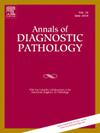TRPS1 expression in cytologic specimens of salivary duct carcinoma and other salivary gland tumors
IF 1.4
4区 医学
Q3 PATHOLOGY
引用次数: 0
Abstract
Recent studies suggest that trichorhinophalangeal syndrome type 1 (TRPS1) is sensitive immunomarker for breast carcinoma (BC). Salivary duct carcinoma (SDC) of salivary gland can share similar morphologic and immunophenotypic features with BC. This study aimed to assess the expression of TRPS1 in SDC and other salivary gland tumors (SGTs). Cytology cases and selected surgical specimens of SGTs were retrieved. Forty-three cases were selected and TRPS1 immunohistochemistry (IHC) was performed on cell blocks and some histologic specimens.
Of those 43 cases, all 13 SDC cases showed TRPS1 expression except for one case. The remaining 30 cases include pleomorphic adenoma (n = 7), Warthin tumor (n = 4), basal cell adenoma (n = 3), adenoid cystic carcinoma (n = 2), secretory carcinoma (n = 5), mucoepidermoid carcinoma (n = 4), and acinic cell carcinoma (n = 5). Three of thirty cases were negative for TRPS1 while the remainder showed variable expression of TRPS1 ranging from focal weak to diffuse strong staining. The three negative cases include a case of secretory carcinoma, mucoepidermoid carcinoma and Warthin tumor. Our study confirmed that TRPS1 expression is present in SDC and other SGTs, indicating an overlapping immunoprofile with breast cancer. Additionally, it may not help differentiate SDC or SGTs from each other. Further studies with larger cohorts are needed.
唾液腺导管癌和其他唾液腺肿瘤细胞学标本中 TRPS1 的表达。
最近的研究表明,毛细血管畸形综合征 1 型(TRPS1)是乳腺癌(BC)的敏感免疫标记物。唾液腺的唾液腺导管癌(SDC)在形态学和免疫表型上与乳腺癌有相似之处。本研究旨在评估 TRPS1 在 SDC 和其他唾液腺肿瘤(SGTs)中的表达。研究人员检索了细胞学病例和部分 SGTs 手术标本。对43个病例的细胞块和部分组织学标本进行了TRPS1免疫组化(IHC)检测。在这43例病例中,除一例外,其余13例SDC病例均有TRPS1表达。其余30例包括多形性腺瘤(7例)、Warthin瘤(4例)、基底细胞腺瘤(3例)、腺样囊性癌(2例)、分泌性癌(5例)、粘液表皮样癌(4例)和棘细胞癌(5例)。30 个病例中有 3 例 TRPS1 阴性,其余病例的 TRPS1 表现不一,从局灶性弱染色到弥漫性强染色不等。三例阴性病例包括一例分泌性癌、粘液表皮样癌和华氏瘤。我们的研究证实,TRPS1 在 SDC 和其他 SGT 中均有表达,这表明其与乳腺癌的免疫图谱存在重叠。此外,它可能无助于区分 SDC 或 SGT。还需要对更大的群体进行进一步研究。
本文章由计算机程序翻译,如有差异,请以英文原文为准。
求助全文
约1分钟内获得全文
求助全文
来源期刊
CiteScore
3.90
自引率
5.00%
发文量
149
审稿时长
26 days
期刊介绍:
A peer-reviewed journal devoted to the publication of articles dealing with traditional morphologic studies using standard diagnostic techniques and stressing clinicopathological correlations and scientific observation of relevance to the daily practice of pathology. Special features include pathologic-radiologic correlations and pathologic-cytologic correlations.

 求助内容:
求助内容: 应助结果提醒方式:
应助结果提醒方式:


